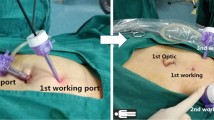Abstract
Introduction
The “MILOS concept” (mini/less open sublay repair) was developed to realize the benefits of minimally invasive surgery and avoid the disadvantages of traditional open techniques in repair of primary and secondary abdominal wall hernias. Utilizing the MILOS concept, the mesh can be placed in the retromuscular position without opening of the abdominal cavity or without the necessity to perform a large skin incision. The dissection of the retromuscular plane may be done by an open technique (MILOS) or endoscopically (EMILOS).
Patients and methods
From June 2015 to July 2016, a total of 33 patients were operated using the MILOS concept, 8 patients underwent the original MILOS technique, and 25 patients had the EMILOS operation. The operative steps of this novel endoscopic variation, the EMILOS procedure (endoscopic mini/less open sublay), are described in detail. Operative indications were a midline umbilical, epigastric, or incisional hernia with a coexisting rectus diastasis. In all cases, a large mesh (20 × 30) was implanted in the retromuscular space without any fixation.
Results
The average skin incision was 5.2 cm; mean operative time was 157 min and 122 min in the last five cases. The average hospital stay was 3.2 days. The median pain score (VAS) under physical stress (e.g., climbing stairs) was 2.7.
Conclusion
The EMILOS operation has the potential to become an important supplementary method in the spectrum of surgical techniques for repair of abdominal wall hernias. The technique is reliable, reproducible, and easy to standardize.














Similar content being viewed by others
References
Bittner R, Bingener-Casey J, Dietz U, Fabian M, Ferzli GS, Fortelny RH, Köckerling F, Kukleta J, Leblanc K, Lomanto D, Misra MC, Bansal VK, Morales-Conde S, Ramshaw B, Reinpold W, Rim S, Rohr M, Schrittwieser R, Simon T, Smietanski M, Stechemesser B, Timoney M, Chowbey P (2014a) Guidelines for laparoscopic treatment of ventral and incisional abdominal wall (International Endohernia Society (IEHS))—Part I. Surg Endosc 28(1):2–29
Al Chalabi H, Larkin J, Mehigan B, McCormick P (2015) A systematic review of laparoscopic versus open abdominal incisional hernia repair, with meta-analysis of randomized controlled trials. Int J Surg 20:65–74
Sauerland S, Walgenbach M, Habermalz B, Seiler CM, Miserez M (2011) Laparoscopic versus open surgical techniques for ventral or incisional hernia repair. Cochrane Database Syst Rev 16(3):CD007781
Arita NA, Nguyen MT, Nguyen DH, Berger RL, Lew DF, Suliburk JT, Askenasy EP, Kao LS, Liang MK (2015) Laparoscopic repair reduces incidence of surgical site infections for all ventral hernias. Surg Endosc 29(7):1769–1780
Awaiz A, Rahman F, Hossain MB, Yunus RM, Khan S, Memon B, Memon MA (2015) Meta-analysis and systematic review of laparoscopic versus open mesh repair for elective incisional hernia. Hernia 19(3):449–463
Bittner R, Bingener-Casey J, Dietz U, Fabian M, Ferzli G, Fortelny R, Köckerling F, Kukleta J, LeBlanc K, Lomanto D, Misra M, Morales-Conde S, Ramshaw B, Reinpold W, Rim S, Rohr M, Schrittwieser R, Simon T, Smietanski M, Stechemesser B, Timoney M, Chowbey P (2014b) Guidelines for laparoscopic treatment of ventral and incisional abdominal wall hernias (International Endohernia Society [IEHS])—Part III. Surg Endosc 28(2):380–404
Reinpold W (2015) Endoskopisch total extraperitonealer transhernialer sublay –Bauchwand-Hernienverschluss in single-port-technik. In: Schumpelick V, Arlt G, Conze J, Junge K (eds) Hernien, 5th edn. Thieme, Stuttgart, pp. 301–304
Köhler G, Luketina RR, Emmanuel K (2015) Sutured repair of primary small umbilical and epigastric hernias: concomitant rectus diastasis is a significant risk factor for recurrence. World J Surg 39(1):121–126
Misra MC, Kumar S, Bansal VK (2008) Total extraperitoneal (TEP) mesh repair of inguinal hernia in the developing world: comparison of low-cost indigenous balloon dissection versus direct telescopic dissection: a prospective randomized controlled study. Surg Endosc 22(9):1947–1958
Conze J, Prescher A, Klinge U, Saklak M, Schumpelick V (2004) Pitfalls in retromuscular mesh repair for incisional hernia: the importance of the “fatty triangle”. Hernia 8(3):255–259
Köckerling F, Botsinis MD, Rohde C, Reinpold W (2016) Endoscopic-assisted linea alba reconstruction plus mesh augmentation for treatment of umbilical and/or epigastric hernias and rectus abdominis diastasis - early results. Front Surg 3:1–6
Bellido Luque J, Bellido Luque A, Valdivia J, Suarez Gráu JM, Gomez Menchero J, García Moreno J, Guadalajara Jurado J (2015) Totally endoscopic surgery on diastasis recti associated with midline hernias. The advantages of a minimally invasive approach. Prospective cohort study. Hernia 19(3):493–501
Schroeder AD, Debus ES, Schroeder M, Reinpold WM (2013) Laparoscopic transperitoneal sublay mesh repair: a new technique for the cure of ventral and incisional hernias. Surg Endosc 27(2):648–654
Costa TN, Abdalla RZ, Santo MA, Tavares RRFM, Abdalla BMZ, Cecconello I (2016) Transabdominal midline reconstruction by minimally invasive surgery: technique and results. Hernia 20(2):257–265
Acknowledgments
We would like to thank David Chen, M.D., Associate Professor of Clinical Surgery, Clinical Director, Lichtenstein Amid Hernia Clinic at UCLA, Section of Minimally Invasive Surgery, UCLA Division of General Surgery, for editing the manuscript.
Author information
Authors and Affiliations
Ethics declarations
Conflict of interest
The authors declare that they have no conflict of interests.
Ethical approval
All procedures performed in studies involving human participants were in accordance with the ethical standards of the institutional and/or national research committee and with the 1964 Helsinki declaration and its later amendments or comparable ethical standards.
Informed consent
Informed consent was obtained from all individual participants included in the study.
Rights and permissions
About this article
Cite this article
Schwarz, J., Reinpold, W. & Bittner, R. Endoscopic mini/less open sublay technique (EMILOS)—a new technique for ventral hernia repair. Langenbecks Arch Surg 402, 173–180 (2017). https://doi.org/10.1007/s00423-016-1522-0
Received:
Accepted:
Published:
Issue Date:
DOI: https://doi.org/10.1007/s00423-016-1522-0




